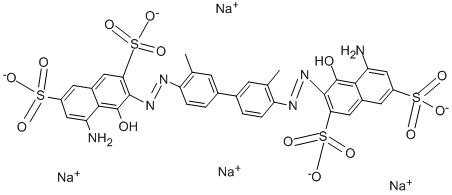Trypan Blue , Biologicalstain , 72-57-1
Synonym(s):
Trypan Blue;Direct blue 14;Direct Blue 14, AzidinBlue;Niagara blue reagent;Blue cell viability dye
CAS NO.:72-57-1
Empirical Formula: C34H24N6Na4O14S4
Molecular Weight: 960.81
MDL number: MFCD00003969
EINECS: 200-786-7
| Pack Size | Price | Stock | Quantity |
| 5G | RMB71.20 | In Stock |
|
| 25G | RMB191.20 | In Stock |
|
| others | Enquire |
PRODUCT Properties
| Melting point: | >300 °C (lit.) |
| Density | 1.007 g/mL at 20 °C |
| bulk density | 800kg/m3 |
| storage temp. | dry at room temperature |
| solubility | H2O: soluble10mg/mL |
| Colour Index | 23850 |
| form | Powder |
| color | Dark greenish-brown |
| PH | 9.8 (10g/l, H2O, 20℃) |
| Water Solubility | 10 g/L (25 ºC) |
| λmax | 607 nm |
| ε(extinction coefficient) | ≥60000 at 603-607nm in methanol at 0.01g/L 60000 at 603-607nm in methanol |
| Merck | 14,9792 |
| BRN | 4360496 |
| Stability: | Stable. Incompatible with strong oxidizing agents. |
| CAS DataBase Reference | 72-57-1(CAS DataBase Reference) |
| IARC | 2B (Vol. 8, Sup 7) 1987 |
| EPA Substance Registry System | Trypan blue (72-57-1) |
Description and Uses
Trypan Blue is an azo based, hydrophilic, tetrasulfonated blue acid dye widely utilized for assessing cell viability. As an easy method to determining the viability of cells, Trypan Blue will stain dead cells with permeable membranes blue, while the dye is excluded by most living cells and their intact membranes thereby allowing visual determination of living versus dead cells. Although Trypan Blue is predominately used for assessing cell viability of cultured cells, other applications for this dye have been reported. In rat abdominal organ slices Trypan Blue has been utilized to determine cell viability as well as islet cell cluster cell viability from caprine pancreatic samples. Dyes and metabolites.
Safety
| Symbol(GHS) |  GHS08 |
| Signal word | Danger |
| Hazard statements | H350 |
| Precautionary statements | P201-P202-P280-P308+P313-P405-P501 |
| Hazard Codes | T,Xi |
| Risk Statements | 45-41-37/38-36/37/38-22 |
| Safety Statements | 53-45-36/37/39-36-26 |
| RIDADR | 2811 |
| WGK Germany | 3 |
| RTECS | QJ6475000 |
| TSCA | Yes |
| HS Code | 32041400 |
| Hazardous Substances Data | 72-57-1(Hazardous Substances Data) |
| Toxicity | LD100 i.v. in rats: 300 mg/kg (Anderson) |


